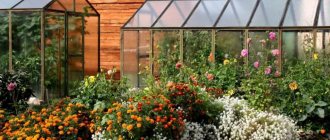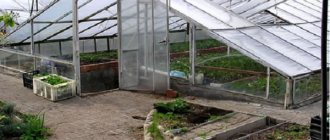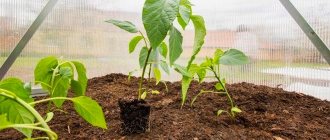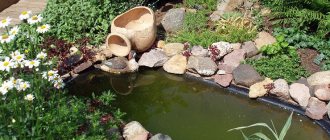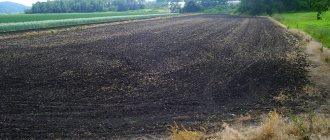Svetlana Leonova
| 10823 | 3 | Print Click Print or CTRL+P to print the page |
Self-assembly of a greenhouse is not difficult. Most summer residents and gardeners who have purchased a ready-made greenhouse design kit are frightened by the possible difficulties that arise when independently assembling and installing such a structure. High-quality installation of greenhouses is carried out by numerous installation organizations and private craftsmen for a very reasonable fee. However, self-assembly of a greenhouse is also not difficult, and to make it as easy as possible to build a frame with your own hands, instructions for assembling the greenhouse are attached to each factory product. It is customary to use timber as a base for factory structures.
Basic principles for choosing a location on a site and installing a greenhouse with your own hands
To create optimal conditions for cultivating plants in the shelter and obtain a bountiful harvest, it must be positioned correctly. The structure must be installed taking into account all the features of the site:
- Soil type;
- Landscape features;
- Direction of the wind;
- Location of communications and other buildings.
We analyze the landscape features of the site
The following criteria are assessed before installation.
Soil type:
- Installing a greenhouse on too soft soil over time leads to significant subsidence or tilting. As a result, the strength of the building is compromised: the coating is destroyed, the frame is damaged, and the doors stop closing. Therefore, it is necessary to have good drainage and create a foundation;
- You should not install a greenhouse on clay soil, since clay retains moisture during watering, and this can lead to water stagnation and increased humidity in the room. However, if there is no choice, first they dig a pit and replace the clay layer with a sand cushion, under which they place a drainage layer, and then fill it with a fertile layer. Only after these measures can the greenhouse be installed;
- The location for the greenhouse should not be located near groundwater.
Presence of slope:
- It is not recommended to install the structure on a site with a slope. The optimal place is a flat area with solid soil;
- Longitudinal and transverse inclination of the building is not allowed. Installing a greenhouse on a site with a slope is only possible with the construction of a foundation.
Greenhouse and wind rose
Pay attention to the compass rose. The greenhouse on the site should be placed in a place that is not very ventilated. To provide wind protection, it would be nice if low-growing bushes are planted around the perimeter of the greenhouse, and the wall on the north side is blank. The optimal distance to such a fence is considered to be no closer than 5-6 meters. It is worth noting that if you cannot close the greenhouse from the wind, you will have to strengthen its frame so that the wind does not damage the covering material of the greenhouse.
In my opinion, you should not completely block the greenhouse from the wind, since natural air exchange should be organized in it. Don't worry about your plants getting cold. The heat from the ground heated during daylight hours will be enough for a comfortable temperature at night.
Orientation of the greenhouse according to the cardinal directions
Further illumination of cultivated plants is determined by the location of the greenhouse relative to the cardinal directions. Ignoring this criterion will cause crops to lack sunlight and significantly reduce yield. Light compensation through artificial lighting sources will increase energy costs. To make the most of free solar energy, it is better to position the building taking into account the cardinal directions. It is worth placing it in a west-east direction. This will allow the plants to receive natural light throughout the day, and will significantly reduce lighting and heating costs when operating the structure in winter.
Design Features
A trench greenhouse is a structure with solid walls, buried to the depth of soil freezing. This feature allows you to use the heat accumulated in the soil over several cold months.
Trench greenhouse
The walls of the greenhouse are made of heat-intensive materials and are insulated from the outside to avoid cooling from the upper freezing layers of the soil. Additionally, the soil is protected from freezing using an insulated blind area around the entire perimeter of the greenhouse.
The roof can be of any shape - arched, gable or pitched. It is covered with two layers of polycarbonate with insulation of the air space between them or frames with double glazing. When the greenhouse is oriented from west to east, the northern slope of the roof can be sewn tightly to reduce heat loss.
Trench greenhouse with arched roof
The entrance to the greenhouse is located at the end and is equipped with an insulated vestibule. To descend into the greenhouse, a staircase is made in the vestibule. You can also place heating equipment or a storage room for storing tools and planting material - tubers, cuttings and bulbs.
Stove in the vestibule of a trench greenhouse
The recessed greenhouse is equipped with a forced supply and exhaust ventilation system. For this purpose, plastic pipes and built-in fans are used. When using glazed frames, some of them can be made to open - in the summer this will help avoid overheating.
Fans for forced air exchange in a greenhouse
In the southern regions, in a trench greenhouse in winter the temperature does not drop below zero even without additional heating. In temperate latitudes, during frosts it needs to be heated. A stove, electric heaters or a water boiler can be used as a heating device.
Stove heating of a trench greenhouse
Effective heating can be achieved by laying a heating cable or water heating pipes in the ground. The heated soil is capable of releasing heat into the greenhouse space for a long time and warming the air.
Scheme of soil heating using an electric cable
Plants in a trench greenhouse can be placed either on beds or on racks. The beds are made of brick or concrete blocks - the walls are an additional heat accumulator. The height of the beds is made within 0.8-1.2 m so that the plants receive enough sunlight. Fill with organic components to obtain the effect of a warm bed and additional heating.
Raised beds in a trench greenhouse
When growing plants on shelves, it is better to concrete the floor, having previously laid waterproofing and insulation boards underneath it. In this case, it is better to place additional heating under the shelving.
Growing container plants and seedlings in a trench greenhouse
How to install a greenhouse taking into account the wind?
When placing a greenhouse, it is necessary to take into account the direction of the wind in order to reliably protect the structure from gusts of wind:
- If the building is located in a draft, then the temperature inside the room will be too low for cultivating heat-loving plants. Even if there is a small area, give preference to a quiet, windless place;
- With the help of other buildings, you can also create maximum protection for the building from gusts of wind, but they should not interfere with the access of light;
- It is especially important to protect the greenhouse from north winds;
- To protect the building from the effects of wind, a hedge is planted or a blind fence is installed. It is necessary to correctly calculate the height of the fence and its distance from the greenhouse structure. Shrubs are planted at a distance of 20 meters, and the fence is at least 7 meters if the height of the building is two meters.
Where and how should the greenhouse be placed?
The placement of a greenhouse on a summer cottage plays an important role in its effectiveness. Please pay attention to the following greenhouse placement requirements:
- The main requirement is that the location of the greenhouse must be well lit and have reliable protection from gusts of northern winds. To satisfy this requirement, it is recommended to install the greenhouse from west to east (the longitudinal axis of the greenhouse faces north/south).
- It is also recommended to place the greenhouse in a visible place, preferably near a residential building.
- If a utility block or a place for storing garden tools and necessary materials (sand, sawdust, etc.) has already been built at the dacha, be sure to place the greenhouse next to them.
- If the garden plot is no more than 6 acres, it will not be possible to build a large greenhouse, because... There's not much room anyway. To somehow win space for a greenhouse, combine it with a residential building, summer kitchen or other building.
- One of the end walls of the greenhouse should be shorter so that the structure is slightly inclined to the west (this arrangement will allow the sun's rays to spread evenly across the entire area of the greenhouse).
- Another advantage of locating the greenhouse near other buildings is that it protects the greenhouse from gusts of wind.
- To create additional lighting for the greenhouse, it is recommended to install reflective screens covered with white paint at a distance of 1 meter from it, on the north side. These screens will reflect the sun's rays towards the greenhouse.
- To improve the temperature regime of the greenhouse, deepen it 0.7 - 0.8 meters into the soil, but do not overdo it, because a heavily recessed greenhouse will leave low-growing plants in the shade.
- Do not forget that the greenhouse requires electricity and water, so it is better to install it close to the electricity and water supply system.
- Do not install the greenhouse near trees, because they will create unnecessary shadow.
How to build a greenhouse on the roof of a house?
Placing a greenhouse building on the roof of a house significantly saves space and creates optimal conditions for cultivating plants. Receiving maximum solar energy will provide plants with more heat. You can also build a greenhouse structure not only in the private sector, but also use the roof of an apartment building. However, you should know that a greenhouse placed on the roof has special requirements both for the design and for the technology of cultivating vegetable crops. Main features of placing a greenhouse structure on the roof:
- Give preference to structures that are as light as possible and at the same time quite strong;
- As a coating, choose not glass, but polycarbonate;
- The frame must also be durable;
- The roof of the greenhouse should have an arched shape to reduce snow and wind loads.
Existing options for placing a greenhouse building:
- Build an additional transparent bay window;
- Install the finished structure on the existing roof;
- Rearrange the roof by building a kind of floor on it, which will have transparent walls, that is, rebuild the attic.
Before installing a greenhouse, you must read the documentation for the residential premises and calculate the load-bearing capacity of the floors to avoid possible problems. During calculations, also take into account the weight of the soil.
The roof covering also needs to be prepared for the construction of a greenhouse building:
- Provide additional waterproofing coverage;
- When arranging, do not forget about the water supply system. Since independent delivery of water to a height is quite difficult, it is better to use a drip irrigation system;
- To ensure air access to crops, it is necessary to have the maximum number of vents. This will prevent the plants from burning from overheating during hot days.
Installing a greenhouse on the roof of a high-rise building will be an excellent option for growing crops for residents who do not have suburban summer cottages. By following all the rules for placing greenhouse structures on personal plots and roofs of residential premises, and also taking into account all the listed nuances, any gardener can get a bountiful harvest.
Underground greenhouses on noble estates
As soon as we decided to build an underground greenhouse in Prosperity, I immediately began to come across various interesting materials on this topic. I will collect the most interesting things.
Leo Tolstoy's underground greenhouse
Nowadays there is a lot of talk about underground greenhouses as a modern invention, but our gardeners had such greenhouses 150 years ago. One of them was preserved in the estate of the famous vegetarian, writer Leo Tolstoy in Yasnaya Polyana. Leo Tolstoy was not only a brilliant writer, but also an excellent gardener, agrarian, beekeeper and teacher.
On his small plot, he grew all the vegetables the family needed. Almost the same area as for the vegetable garden was allocated to Russian greenhouses. In the spring they were filled with manure, fortunately it accumulated in abundance: there were stables on the estate.
Count Tolstoy designed and equipped the underground greenhouse (it still operates to this day) with his own hands in the 70s on the site of a building that burned down in 1867.
the greenhouse of Prince N. S. Volkonsky. From the outside it is unprepossessing, with a low ridge and gently sloping glazing. But the snow quickly rolls off the roof and it’s quite light in the greenhouse. Inside, the greenhouse is two-level, spacious and high, as it is buried in the soil (almost 2 m). Earthen walls lined with timber retain heat.
At Tolstoy's, peach and cherry trees bore fruit in tubs; Turgenev has pears in greenhouses and greenhouses. Prince Vyazemsky had about a thousand such tubs, Turgenev also had a significant number: he had winter gardens... After the abolition of serfdom, more crops began to be planted in open ground.
This, of course, is less labor-intensive - after all, greenhouses need to be heated and ventilated...
In the museum greenhouse, pomegranates, figs, peaches, and coffee are now growing in tubs. Once upon a time, the Tolstoys grew coffee, mixed it with dried chicory roots, and even took it to Moscow for sale.
What kind of greenhouses, greenhouses and vegetable gardens were there in noble estates?
In addition to the popular landscape design that many homeowners are now keen on, greenhouses and greenhouses with exotic plants used to be an integral part of a noble estate.
The nobles kept greenhouses, greenhouses and hothouses in which fresh herbs, cucumbers, and exotic vegetables were grown to surprise their neighbors. Moreover, many estate owners did not consider it shameful to work in them.
Greenhouses, as a rule, were built of wood, and stone cellars were built for growing seedlings.
For many nobles, vegetable growing was a serious hobby, and sometimes one of the few joys in life. Like, for example, the Decembrists exiled to Siberia.
Greenhouse Museum in Tarkhany
Volkonskaya was the first in Eastern Siberia to plant carotel, dwarf beans, tomatoes, maize, celery, spinach, purslane, and tarragon. She had four types of melons - “Dubrovka, real, cantaloupe and Persian.”
Moreover, even in the courtyard of the Chita prison, Maria Nikolaevna, together with her husband, set up a small greenhouse and taught her friends to “plant a vegetable garden.”
The princess sowed cucumbers, with her own hands, on high manure beds for cucumbers in the yard behind the stables. From frosts, which happened even in July, the crops were covered with “felt and carpets.” “I,” the princess wrote to her mother-in-law in the fall of 1829, “have cauliflower, artichokes, wonderful melons and watermelons and a supply of good vegetables for the whole winter.”
Nevertheless, the composer’s father tried very hard to diversify the vegetation of the estate in order to somehow distract his French wife from sadness and pamper his children with rare vegetables.
He ordered to build a vegetable garden, insulate leaky greenhouses and build a greenhouse that would be in harmony with other buildings (a glacier with a pit for storing vegetables, stables, a barn).
The greenhouse was made of logs, with high and quite wide windows for those times for good illumination of the plants, had the shape of the letter L and was heated by special stoves. It had a room for a gardener, who monitored the heating of the room around the clock.
The owner himself did not work in the greenhouse, but carefully observed the plants. For example, in April 1837, he wrote in his work journal that “the cucumbers are already on their fifth leaf.” I. Tchaikovsky often visited the greenhouse and brought his children to harvest the crops.
This is a good example of what we should do in an era of shortages of natural products and a crisis in raising our children.
General rules
Most novice summer residents, and some experienced gardeners, quite often wonder how to properly install a greenhouse on their plot in order to get the maximum benefit from purchasing such a structure. Before assembling a greenhouse in a permanent location, it is very important to determine the presence of the most favorable factors:
- the most flat area;
- lack of nearby groundwater;
- absence of buildings and vegetation capable of shading the greenhouse;
- the area under the greenhouse structure must be protected from drafts and gusty winds;
- availability of communications necessary to maintain the structure;
- the highest quality and fertile soil for growing plants.
Installation of a greenhouse always involves taking into account some of the requirements that apply to the place for such a structure.
It is not recommended to install the structure in excessively moist or shaded areas.
Selecting a location
Installation of a greenhouse always involves taking into account some of the requirements that apply to the location for such a structure. Before assembling the greenhouse, you should determine its location on the site. As a rule, summer residents try to create the most attractive and elegant ensemble out of all buildings. In this case, the correct location of the greenhouse is not taken into account at all. According to the rules, the greenhouse must be installed in accordance with the cardinal directions:
- the meridional type of installation of the greenhouse on the ground involves the location of the façade parts of the structure to the north and south, while the side slopes will be oriented to the east and west;
- The latitudinal type of installation of a greenhouse on the ground is characterized by the reverse location of the structure, and the greenhouse facades will be oriented to the west and east, and the side parts to the north and south.
The best option is to place the structure on a flat and well-lit area.
It should be remembered that the assembly of the greenhouse can be done with your own hands after a thorough examination of the construction site. The best option is to place the structure on a flat and well-lit area.
Installation on a slope
If it is not possible to find the most flat surface of the ground, and you have to install the greenhouse on a sloping or damp area, then you should perform the following steps to minimize maintenance problems for such a structure:
- marking the area for the greenhouse in accordance with the main dimensions of the structure. It should be noted the flattest place, which will serve as a passage in the middle of the greenhouse;
- mark the drainage system, which will not allow water to accumulate near the root system of plants.
The type of foundation depends on the category of the greenhouse, its size, as well as the material used for covering
The main stages of leveling, which will need to be done with your own hands, will be carried out during the construction process. Most often, special linings are used, which can be brick or timber, as well as the method of adding earth. When adding soil, you should take into account the weight load of the greenhouse structure, as well as the location of groundwater.
What size to build a greenhouse
To determine the size of the future greenhouse, it is necessary to plan the beds in advance. The planting area near the walls of the greenhouse should not be more than 60-70 cm, the optimal width of the passage should be 30-40 cm. If you decide to place a bed between the passages, then give it a space of 1.2 - 1.4 meters. These sizes are due to the ease of caring for the beds. On my site I built a greenhouse measuring 3x6 meters and 2.5 meters high. This amount of space allows you to maintain comfortable conditions for plants in the greenhouse.
How the greenhouse will be located on the site largely determines how the plants will feel and what kind of harvest you can get. Installing a greenhouse is not difficult, it is important to think about where...
In the next article I will tell you how to make a greenhouse with your own hands.
I RECOMMEND ALSO READING:
Installation features
Most often, factory greenhouse structures based on polycarbonate sheets are installed with your own hands, the installation of which is carried out in accordance with the attached instructions in several stages.
- Complete assembly of the frame according to the diagram included in the instructions with arrangement of the end parts with cut polycarbonate sheets.
- Deepening the T-shaped tips of the assembled frame structure into the ground, followed by backfilling with earth.
- Cut the plastic and cover the entire greenhouse structure with sheets of cellular or monolithic polycarbonate.
- It is not recommended to leave a self-assembled structure slightly buried in the ground for a long time, since strong winds can overturn the greenhouse. For the purpose of permanent fastening, a beam or shallow foundation can be used. If timber is used, it is laid on a waterproofing layer of roofing felt or similar material.
- When attaching structures to beams, special attention should be paid to ensuring that the structure stands as level as possible, and that window and door openings do not have even slight distortions.
- If the design features and installation of greenhouses require the use of sealing tapes, then these elements must be laid carefully at the joints of the structure.
- It is necessary to build a greenhouse with your own hands so that the number of cracks and gaps between the frame and the covering material is minimal. Otherwise, the greenhouse soil may cool, and the temperature inside the structure will be insufficient for growing heat-loving garden crops.
- If sheet polycarbonate is used as a covering, then the edges of such material must be dug into the ground at least five centimeters.
- When using a film covering, the covering material should be secured to the timber using a wooden or metal strip.
Types of greenhouses
First of all, buildings for growing plants are divided into greenhouses and greenhouses.
The greenhouse is a quadrangular wooden structure dug into the ground, filled with manure inside and stretched with film. Despite the simplicity of the design, this building is very effective. The disadvantage of a greenhouse is its seasonality and inability to heat.
Greenhouse for plants
Greenhouses are more complex buildings for growing plants. There are 2 main types of greenhouses: capital and seasonal.
Capital greenhouses are constructed from wooden beams or metal profiles with a foundation (basement or columnar). This type of greenhouse has greater resistance to winds and is permanently located on a summer cottage.
Seasonal greenhouses are less complex structures that do not require a foundation and are installed only in the summer. This type of greenhouse is very popular because... there is no need to create a permanent structure. On the agricultural goods market you can see a wide range of seasonal greenhouses, the price of which is not very high, and the advantage is that the design can be folded down to small sizes, so in winter it can be hidden in a utility room.
Video tutorial on how to do a greenhouse with your own hands
Greenhouse installation (video)
Before purchasing a ready-made greenhouse structure, you should decide on the location of such a structure on the site and the possibility of assembling it yourself. In addition, care should be taken to ensure that the wooden beam used as the bottom frame has undergone high-quality aseptic processing and is laid as evenly as possible. If the soil on a personal plot is not suitable for growing greenhouse plants, then it is advisable to add a special nutrient soil mixture to the greenhouse, which helps increase productivity and reduces the cost of feeding plants with expensive fertilizers.
In order not to lose the material, be sure to save it to your social network VKontakte, Odnoklassniki, Facebook by simply clicking on the button below:
| 8842 | 3 | Print Click Print or CTRL+P to print the page |
